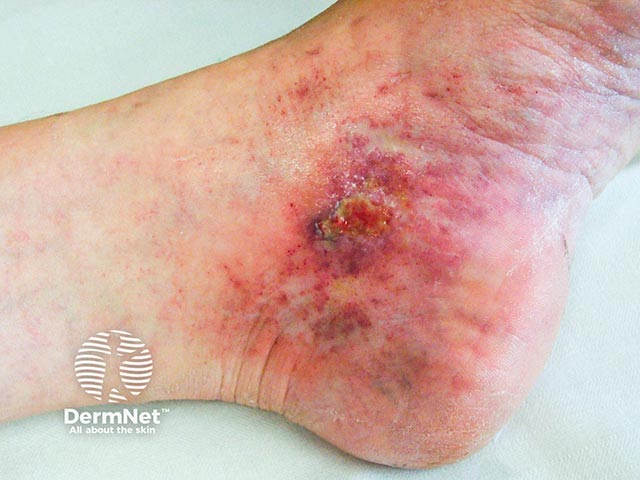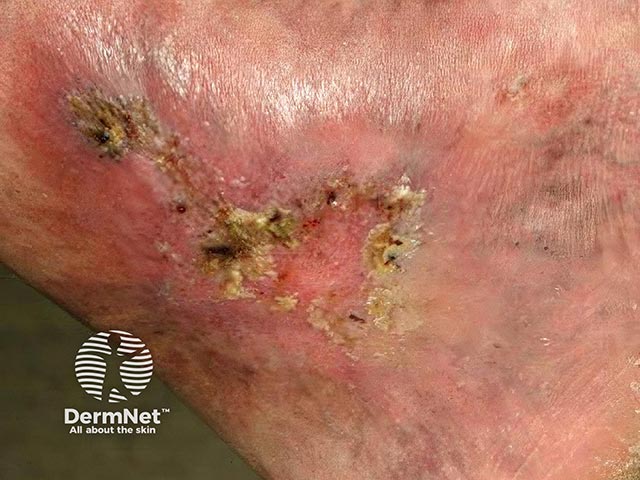Main menu
Common skin conditions

NEWS
Join DermNet PRO
Read more
Quick links
Livedoid vasculopathy — extra information
Livedoid vasculopathy
Author: Vanessa Ngan, Staff Writer, 2004. Updated by A/Prof Amanda Oakley, January 2016; minor update 2024.
Introduction
Demographics
Causes
Clinical features
Diagnosis
Differential diagnoses
Treatment
Outlook
What is livedoid vasculopathy?
Livedoid vasculopathy is a rare, chronic vascular disorder characterised by persistent painful ulceration of the lower extremities. The condition occurs chiefly but not exclusively on the lower leg or foot.
Livedoid vasculopathy was also known as ‘livedo vasculitis’, ‘livedoid vasculitis’ and ‘livedo reticularis with summer ulceration’. It is now clear that it is not primarily a vasculitis (inflammation of the blood vessel wall), but to occlusion of small blood vessels, hence the change in name.
Who gets livedoid vasculopathy?
Livedoid vasculopathy occurs most commonly in middle-aged women but has been reported at all ages including childhood. There is often an increased incidence during the summer months and pregnancy.
Some patients with livedoid vasculopathy have an associated condition that predisposes them to occlusion of the small vessels of the lower leg. These include:
- Coagulation disorders such as antiphospholipid syndrome with lupus anticoagulant in 18% and anticardiolipin antibodies in 29% in one study
- Fibrinolytic disorders such as protein C deficiency (13%) and factor V mutation (Leiden) in 22% in one study
- Arteriosclerosis
- Homocysteinaemia (14%)
- High levels of lipoprotein (a)
What is the cause of livedoid vasculopathy?
The exact cause of livedoid vasculopathy remains unclear, and various theories have been published referring to abnormalities within the blood vessel wall and in the circulating blood. It is likely that several different abnormalities may lead to clotting within small blood vessels of the lower legs. The thrombi result in necrosis of overlying skin, ulceration and very slow healing. There is no primary vasculitis.
Prothrombin G20210A gene mutation has been found in about 8% of patients.
What are the clinical features of livedoid vasculopathy?
Livedoid vasculopathy affects lower legs, ankles, and upper surfaces of the feet. It is nearly always bilateral. Characteristics include:
- Mild to moderately painful red or purple marks and spots that progress to small, tender, irregular ulcers (30% of cases)
- Painless, irregular atrophie blanche (porcelain-white, stellate scars with red dots due to prominent capillaries)
- Livedo reticularis, Raynaud phenomenon and acrocyanosis may be present in some patients

Atrophie blanche

Atrophie blanche
How is livedoid vasculopathy diagnosed?
After taking a history, the patient should undergo a thorough general examination to identify any underlying associated condition.
Livedoid vasculopathy is a clinical diagnosis, supported by skin biopsy of a red papule or the edge of a new ulcer. Histopathology reveals hyalinisation, thickened blood vessel walls, fibrin deposition, vascular occlusion by thrombosis and minimal inflammation.
Direct immunofluorescence often shows deposition of immunoglobulin and complement components in the superficial, mid-dermal, and deep dermal vasculature (non-diagnostic).
Investigations are not diagnostic for livedoid vasculopathy. They should include:
- Full blood count
- Coagulation studies
- Connective tissue antibodies
- Lupus coagulant and anticardiolipin antibodies
- Homocysteine levels
In many cases of livedoid vasculopathy, the results of these tests are normal.
Imaging studies for peripheral vascular disease may be carried out. Transcutaneous oximetry shows reduced oxygen flow in most patients.
What is the differential diagnosis of livedoid vasculopathy?
- Venous insufficiency with venous eczema and stasis ulcer
- Arterial insufficiency, arterial ulceration and diabetic foot ulcer
- Rheumatoid arthritis
- Systemic lupus erythematosus
- Systemic sclerosis
- Small vessel vasculitis
- Cutaneous polyarteritis nodosa
- Malignant atrophic papulosis
What is the treatment for livedoid vasculopathy?
The main goal of therapy in livedoid vasculopathy is to reduce pain, ulceration and the development of atrophie blanche.
- Protect the area from all knocks, abrasions, known allergens/irritants and ill-fitting shoes to avoid ulceration.
- Remove slough and dead tissue from the ulcers.
- Treat infection (cellulitis) with antibiotics.
- Leg elevation, compression therapy, bed rest, and occlusive wound dressings may aid healing.
- Stop smoking, if relevant, as smoking reduces peripheral blood flow.
Various drug therapies may be prescribed to enhance blood flow and prevent blood clotting:
- Pentoxifylline (alters blood viscosity and red cell flexibility)
- Antiplatelet agents (eg, aspirin, dipyridamole)
- Fibrinolytic agents (eg, danazol, tissue plasminogen activator)
- Anticoagulant agents (eg, subcutaneous heparin injections, oral warfarin, rivaroxaban)
- Vasodilating agents (eg, nifedipine, nicotinic acid)
- Anti-inflammatory agent (eg, prednisone, intravenous immunoglobulin)
- Phenformin and ethyloestrenol (dissolve blood clots)
- Folic acid, vitamin B-12, and vitamin B-6 (cofactors of homocysteine metabolism) for hyperhomocysteinemia
What is the outlook for livedoid vasculopathy?
Livedoid vasculopathy is a chronic disorder, with spontaneous remissions and exacerbations. Reports of disease duration have ranged from 2.5 months to 21 years.
Once livedoid vasculopathy is in remission, over time the white patches of atrophie blanche become less defined and capillaries less prominent.
Bibliography
- Micieli R, Alavi A. Treatment for livedoid vasculopathy: a systematic review. JAMA Dermatol. 2018;154(2):193–202. doi:10.1001/jamadermatol.2017.4374. PubMed
- Vasudevan B, Neema S, Verma R. Livedoid vasculopathy: A review of pathogenesis and principles of management. Indian J Dermatol Venereol Leprol. 2016;82(5):478–88. doi:10.4103/0378-6323.183635. Journal
On DermNet
- Atrophie blanche
- Livedo reticularis
- Vasculitis
- Leg ulcers
- Arterial ulcer
- Lymphocytic thrombophilic arteritis
- Vascular skin problems
Other websites
- Livedoid Vasculopathy — Medscape
